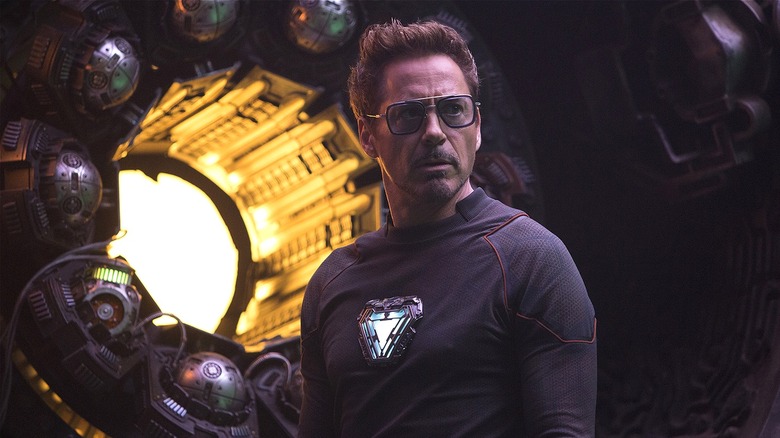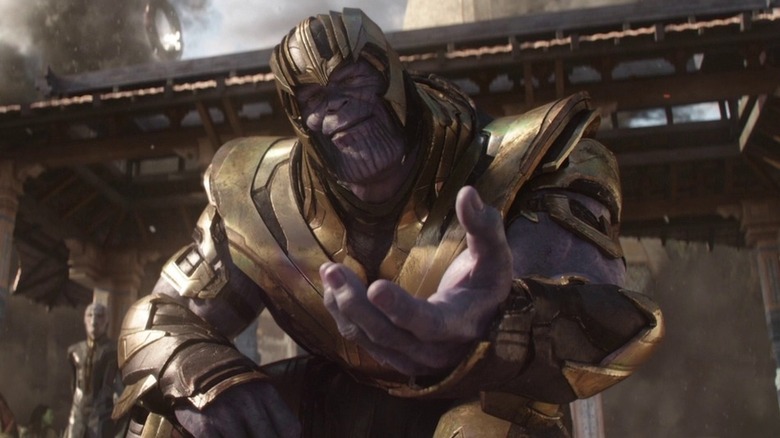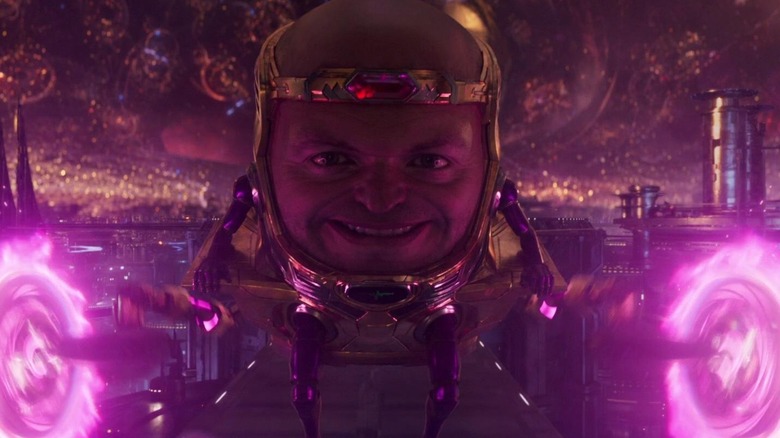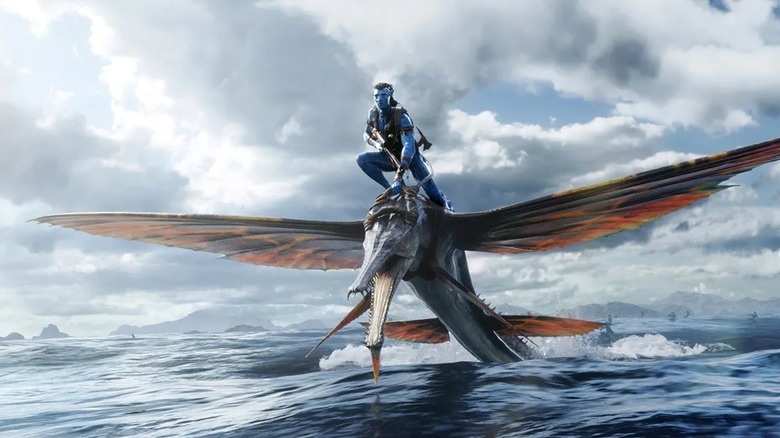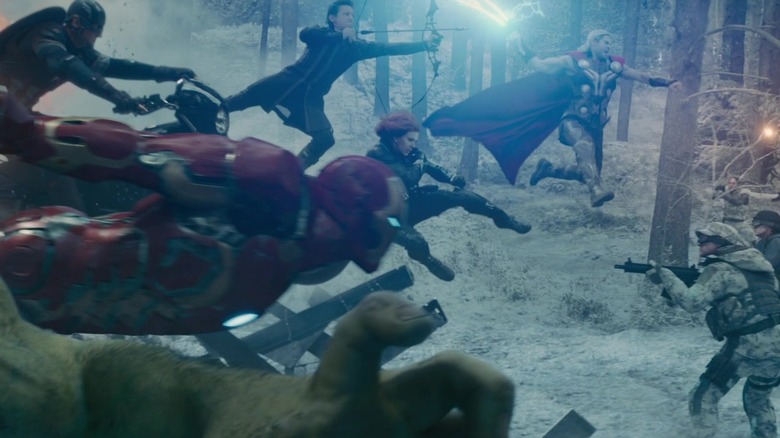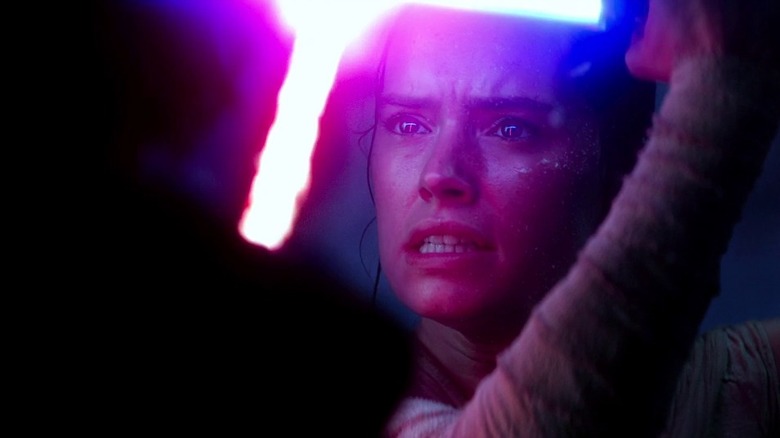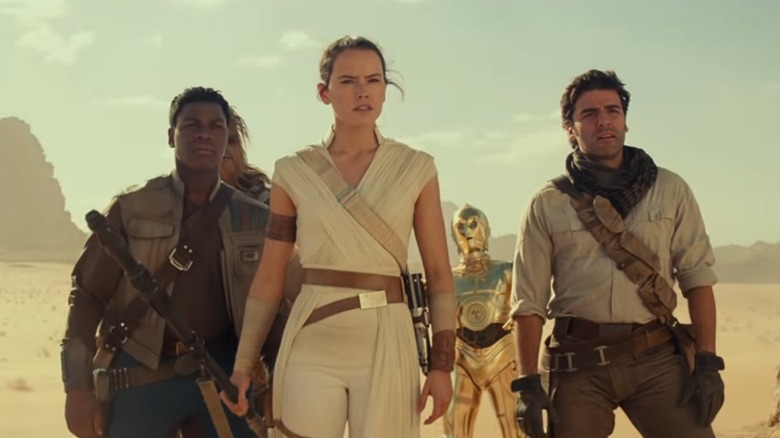12 Most Expensive Disney Movies Ever Made
In the James P. Stewart book "Disney War," there's an anecdote about Disney's then-CEO Michael Eisner being in awe of various concept art pieces for "Pirates of the Caribbean: The Curse of the Black Pearl." This title was struggling to get a green light, and this artwork certainly showed the project's potential. However, Eisner allegedly still hesitated over pursuing the blockbuster. "Why does it have to cost so much?" Eisner inquired, to which "Pirates" producer Jerry Bruckheimer apparently replied, "Your competition is spending $150 million."
In the early 2000s, Warner Bros. and 20th Century Fox were doing circles around the Mouse House in the tentpole domain. Disney quickly unleashed a wave of costly box office smashes on the world, including the "Pirates of the Caribbean" movies, various Marvel Cinematic Universe installments, and a slew of "Star Wars" outings. The days of penning-pinching were done at this studio. In the decades that followed, Disney would no longer express trepidation over spending big bucks to realize blockbuster visions, building up to $250 million flops like "Tron: Ares" and hotly anticipated blockbusters like "Avatar: Fire and Ash."
Disney's 21st-century radical embrace of pricey motion pictures is glaringly apparent when examining the studio's 12 most expensive movies in history. These features (ranked below from least to most costly) all exemplify how Disney now revels in an expensive cinematic domain that Eisner was once so uncertain the studio should ever get involved in.
Pirates of the Caribbean: At World's End
In May 2007, the norms for how much big blockbusters could cost changed drastically. First came "Spider-Man 3" with its reported $258 million budget, making it the first movie (not adjusted for inflation) to reportedly cost over $250 million to make. But "Spider-Man 3" wasn't even the most expensive tentpole of that month. That honor went to Memorial Day 2007's "Pirates of the Caribbean: At World's End," which cost a massive $300 million to bring to the screen.
Given the deluge of groundbreaking visual effects wizardry required to bring the most ridiculous set-pieces in "Pirates of the Caribbean: At World's End" to life, including the motion-capture character Davy Jones and that whirlpool finale, nobody could say that the money wasn't on the screen when it came to this Gore Verbinski picture. However, the film's budget was also exacerbated by external production challenges. Per Verbinski, "At World's End's" post-production was a cramped nightmare, with the team only having 10 weeks for the edit where most films take closer to a year. Disney spent tons of cash ensuring this feature made its May 25, 2007 release date.
Despite burning all that moolah, the Mouse House more than tripled its $300 million budget on "At World's End's" gigantic $963.4 million worldwide box office haul. A seal was now broken. Not only could films cost $300-plus million, but "At World's End" proved they could also be profitable despite hefty costs.
Avengers: Infinity War
It's hard to imagine how some of these films ended up becoming Disney's most expensive movies ever. For 2018's "Avengers: Infinity War," the costs are way more understandable. This grand crossover event in the Marvel Cinematic Universe united so many different cast members, locations, and plotlines from across this fictional realm. Realizing this grand scope would not be a cheap or easy endeavor. Robert Downey Jr. alone cost $75 million to cast in this film, a figure that meant he ate up roughly a quarter of "Infinity War's" $300 million production budget (including promotion and advertising, it was closer to $475 million). Chris Hemsworth, meanwhile, grabbed $15 million for this project, while even Tom Hiddleston, who's only in "Infinity War's" earliest scenes, secured a reported $8 million payday.
Just getting all these actors, from Chadwick Boseman to Mark Ruffalo and Tom Holland (among many others), compensated and signed on for "Infinity War" was a costly exercise. Then there were all the expenses tied to the film's immense digital spectacle. However, every penny was well spent given how spectacularly this production performed at the box office. In its worldwide theatrical run, "Avengers: Infinity War" took in a massive $2.052 billion, making it one of the highest-grossing films of all time.
Despite being one of the most expensive movies (Disney or otherwise) in history, "Avengers: Infinity War" still did a little over six times its enormous production budget. And to think, this tremendously profitable motion picture isn't even the most lucrative "Avengers" title in existence.
Ant-Man and the Wasp: Quantumania
In the pantheon of Marvel Cinematic Universe theatrical features, the original "Ant-Man" from 2015 has the lowest reported budget. Eight years later, though, any sense of cost-consciousness or intimate scale would be abandoned on "Ant-Man and the Wasp: Quantumania," which plunged the franchise's primary faces into the Quantum Realm for a gigantic adventure against Kang the Conqueror (Jonathan Majors). The resulting film was crammed full of CG backgrounds and characters, but "Quantumania" also underwent constant, costly reshoots. This included the project shooting its final ending just a month before "Quantumania's" debut.
All of that combined to give "Ant-Man and the Wasp: Quantumania" a $330 million price tag, a hefty haul to spend on a solo "Ant-Man" feature. The hope was that this production, with its immense scale and heavy ties to now-jettisoned larger Marvel Cinematic Universe plans, would inspire an "Avengers-"sized box office run. Instead, "Quantumania" only grossed $476.07 million worldwide, way below pre-release expectations. That was also considerably beneath the worldwide grosses of the two prior "Ant-Man" movies. Boosting the budget had not guaranteed "Quantumania" the gigantic box office cume it needed to be profitable.
Avatar: The Way of Water
When Disney finished purchasing News Corp media entities like 20th Century Fox, one of the projects it inherited was writer-director James Cameron's gargantuan "Avatar" franchise. "Avatar: The Way of Water" and "Avatar: Fire and Ash" were in the middle of back-to-back shooting as 20th Century Fox transformed into the Disney-owned 20th Century Studios. The former feature was the first "Avatar" outing to be distributed by Disney when it hit theaters in December 2022. The film's corporate owners had changed, but "Avatar" remained a persistently costly enterprise no matter who was footing the bill.
"Avatar: The Way of Water" cost $350 million to produce, a gigantic sum way above the first "Avatar's" $237 million budget. To realize Cameron's oceanic vision for "The Way of Water," this filmmaker and his visual effects team took on the costly endeavor of crafting revolutionary new tools for shooting motion-capture performances underwater. To boot, "The Way of Water" spent way more time in CGI-only Pandora environments compared to its predecessor, which couldn't have been cheap to realize. Like with most Cameron blockbusters, though, the staggering budget ended up paying off thanks to "Avatar: The Way of Water's" successful box office haul of $2.3 billion worldwide.
Avengers: Endgame
Eleven years after "Iron Man" kicked off the whole Marvel Cinematic Universe experiment, "Avengers: Endgame" hit movie theaters as a conclusion to the expansive (and expensive) Infinity Saga. Disney had minimal experience releasing live-action superhero fare before 2012's "The Avengers," but between that film and "Endgame" in 2019, the Mouse House became a master in this cinematic domain. So confident was this studio in its ability to make superhero films profitable that Disney spent $356 million on "Avengers: Endgame," a normally unthinkable sum for just one motion picture.
Like "Infinity War," bringing together all these MCU actors into one movie was no cheap feat. For "Endgame" specifically, additional costs were incurred through lengthy reshoots that spanned from late 2018 to early 2019, including shooting Robert Downey Jr.'s final line as Tony Stark/Iron Man. Getting those thousands of visual effects shots finished in time for "Endgame's" April 2019 bow was also expensive. If ever a movie required such an extravagant price tag, it had to be this culmination of so much superhero cinema storytelling.
It didn't hurt that "Endgame" was a financial goldmine for Disney. The motion picture grossed $2.72 billion worldwide, temporarily making it the biggest movie ever globally before "Avatar" snatched the title back.
Avengers: Age of Ultron
Three years after "The Avengers" took the world by storm, it was time for a sequel. "Avengers: Age of Ultron" saw writer-director Joss Whedon taking the pre-existing Avengers team and pitting them against James Spader's robot baddie Ultron. This particular enterprise was a much more sprawling work than the original "Avengers," with a globe-trotting scale, a larger cast, and a villain that could manifest in so many different robotic forms. "Age of Ultron" ultimately cost $365 million to produce — or $500 million when adjusted for inflation — making it the most expensive of the solo "Avengers" outings. Not even "Avengers: Endgame" was quite so pricey.
At the time of its release, "Age of Ultron" was only the second movie in history to exceed $350 million in its budget. As usual for a standalone "Avengers" adventure, though, all that money preceded an incredible box office run. Having one of the biggest domestic opening weekends ever at the time of its release, "Age of Ultron" grossed $1.4 billion worldwide, including $459 million in North America. While technically the lowest-grossing "Avengers" feature domestically and globally, "Age of Ultron" still made a pretty penny for Disney even after racking up such hefty costs. "Age of Ultron" proved to the studio that bigger was better.
The Marvels
Making a sequel to a box office phenomenon like 2019's "Captain Marvel" should've been a financial slam-dunk. However, director Nia DaCosta's "The Marvels" ran into endless problems that kept pushing its budget higher and further. In the end, it cost an eye-popping $378.5 million to produce — or $325.3 million after U.K. tax credits. (Productions that spend 10% or more of their total budgets in the U.K. are eligible for reimbursements of 25.5% of the money spent in the country.) Though the film had a lower-profile cast than a typical "Avengers" installment or even the star-studded "Thor: Ragnarok," the budget was undoubtedly driven up by the extensive reshoots. DaCosta said this Marvel Cinematic Universe feature never had a concrete script to fall back on, which likely inspired those reshoots to get the feature into coherent shape.
Coordinating that additional photography inevitably boosted the film's budget, particularly since it lasted a whopping four weeks. Plus, this enterprise had tons of CGI-heavy action sequences involving cosmic battles and tears in the space-time continuum. That's not the kind of material that can be realized cheaply. Marvel titles shot in the early 2020s, like "The Marvels," also had their budgets bolstered by COVID protocols, which further ensured this feature would be more expensive than "Captain Marvel."
Any hopes of "The Marvels" reaching the $1-billion-plus worldwide success of "Captain Marvel," though, were quickly dashed. This production only grossed $206.13 million worldwide, including just $84.5 million domestically. Losing an estimated $237 million for Disney (when you factor in the cost of marketing), "The Marvels" was a shocking flop. All of that money Disney spent just couldn't translate to moviegoer interest.
Pirates of the Caribbean: On Stranger Tides
Initially, the plan for "Pirates of the Caribbean: On Stranger Tides" was for this fourth "Pirates" adventure to bring down this franchise's typically massive costs after previous installments had gone so over-budget. Any movie shot on the open sea, though, is bound to run into costly problems. Just ask "Jaws" helmer Steven Spielberg. "On Stranger Tides" had the extra misfortune of shooting in digital 3D, an already cumbersome mode of filming made extra challenging by using those cameras in real-world locations. Executing that 3D cinematography doesn't come cheap, especially with a VFX-heavy blockbuster like "On Stranger Tides."
It didn't help that director Rob Marshall also had a profoundly short post-production period, much like "At World's End" — 22 weeks instead of the filmmakers' preferred 40 — which required material to be edited as it was shot, undoubtedly also driving up the budget. In the end, any hopes of "On Stranger Tides" being a cheaper "Pirates of the Caribbean" installment turned out to be laughable. Instead, "On Stranger Tides" cost a whopping $410.6 million to make — or $378.5 million when you factor in tax credits. For a time, that made it the most expensive movie (Disney or otherwise) in history. Even the $225 million "Pirates of the Caribbean: Dead Man's Chest" suddenly looked like a bargain compared to this 2011 outing.
Still, "On Stranger Tides" made $1.04 billion worldwide once it dropped anchor in multiplexes. Though not a massively profitable production, that mighty global box office haul kept this once "modestly budgeted" feature from being a total financial boondoggle.
Doctor Strange in the Multiverse of Madness
"Doctor Strange in the Multiverse of Madness" had no shortage of problems on its road to the big screen. From the moment original director Scott Derrickson left the project in January 2020, the film suffered endless creative anguish, including constant release date delays, postponements rooted in COVID-19, and even just figuring out what the movie's ending would be deep into principal photography. Then there were those extensive reshoots, which stretched on until just weeks before "Multiverse of Madness" was set to hit theaters.
All of these problems made "Doctor Strange in the Multiverse of Madness" far from a normal Marvel movie. They also ensured that the project would rack up a mighty big price tag. It was eventually revealed that this chaotic film cost Disney $414.9 million ($350.6 after tax breaks) — a budget more in line with massive "Avengers" installments rather than typical solo MCU adventures. The enormous "Multiverse of Madness" budget reflected the costly hazards of shooting sprawling blockbusters during the COVID-19 pandemic. It also reinforced the pricey dangers of not nailing down a tentpole's script before shooting begins. Even with such a towering budget, "Multiverse of Madness" grossed a terrific $952.22 million worldwide, which ensured Disney made an estimated $127.3 million off the film. That outcome provided something soothing for Disney and Marvel Studios executives after a tumultuous production rollercoaster.
Indiana Jones and the Dial of Destiny
Adjusted for inflation, the $20 million budgeted "Raiders of the Lost Ark" from 1981 would cost $71.46 million in today's dollars. 2008's "Indiana Jones and the Kingdom of the Crystal Skull," meanwhile, would cost around $279 million adjusted for inflation. The cost of blockbusters truly ballooned over just that 27-year period alone. In the 15 years between "Crystal Skull" and 2023's "Indiana Jones and the Dial of Destiny," the expenses of "Indiana Jones" adventures would only swell further. "Indiana Jones and the Dial of Destiny" cost a massive $419 million — or $352.3 million after tax credits — a sum that made it costlier than several of Disney and Lucasfilm's "Star Wars" movies.
Adding to those costs, "Dial of Destiny" opens with a lengthy prologue that follows a digitally de-aged Indiana Jones in the final days of World War II. Following a protagonist (even just for the opening sequence) that requires so many post-production alterations alone would explain why the "Dial of Destiny" budget was so immense. Meanwhile, shooting a globe-trotting adventure movie in late 2021 and early 2022 meant that various filming locations were expensively jettisoned at the last minute for COVID-related reasons. Then there was the $10-plus million salary Harrison Ford procured for headlining this feature.
All four classic "Indiana Jones" adventures were global moneymakers. Not "Indiana Jones and the Dial of Destiny," which only grossed $384 million worldwide, making it yet another legacy sequel that flopped at the box office.
Star Wars: The Force Awakens
To say "Star Wars: The Force Awakens" was an essential movie for Disney was a gross understatement. Arriving three years after the Mouse House bought Lucasfilm and announced a new era of "Star Wars" cinema, this kick-off to the Sequel Trilogy was supposed to usher in a new age of "Star Wars" media and immense profits for Disney. Thus, the studio took a cue from John Hammond and "spared no expense" when it came to realizing this J.J. Abrams directorial effort. Whatever this movie needed to succeed, it was going to get.
This meant Disney spent a gargantuan $533.2 million on "The Force Awakens" ($446.6 million after tax credits) — a budget that was undoubtedly boosted by some unforeseen problems during filming. Chiefly, Harrison Ford sustained a major on-set injury that forced production to shut down for two weeks. Keeping all the sets and cast members around for that shutdown couldn't be cheap. "The Force Awakens" also deployed largely practical effects wizardry in real-world locations, a maneuver that brought this title back to the roots of the original three "Star Wars" films. However, it was also a technique that was more expensive to implement than shooting everything against a blue screen in Los Angeles. Add in the inflated cost for bringing back the legacy cast, and this turned out to be an uncommonly expensive film.
Of course, "The Force Awakens" was incredibly profitable. Grossing $2.071 billion worldwide, "The Force Awakens" was a tremendous hit, with its $936 million domestic cume making it the biggest film ever in North America.
Star Wars: The Rise of Skywalker
Four years after "The Force Awakens," it was time to bring the Sequel Trilogy in for a landing. Director J.J. Abrams was back steering the ship for "Star Wars: The Rise of Skywalker," which would end up being an incredibly divisive entry in the "Star Wars" saga. Before all those critical and audience notices, though, Disney and Lucasfilm were just intent on ensuring the project met its December 2019 release date. "The Rise of Skywalker" went through several rewrites, which resulted in actors like Matt Smith having their roles cut entirely. Once principal photography was finished, multiple rounds of reshoots were needed to get the film to its final, controversial form.
These constant creative fluctuations couldn't have been beneficial to "The Rise of Skywalker's" budget, which was eventually revealed to be $593.7 million, or $489.9 million after tax credits. That made it the most expensive motion picture in history. The days of Disney executives having second thoughts over "Pirates of the Caribbean: The Curse of the Black Pearl's" price tag were truly dead and buried.
While "The Rise of Skywalker" technically broke even after grossing $1.07 billion worldwide, it did only a little over two times its budget worldwide. "The Force Awakens," meanwhile, did 4.5 times its price tag globally.
